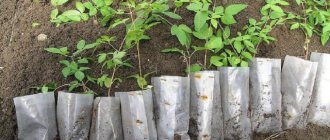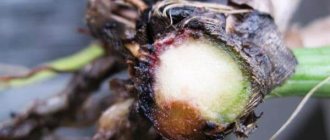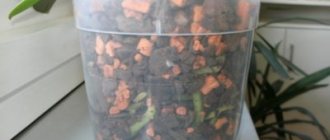Almost all gardeners know about the wonderful effects of succinic acid on plants. What is it? Succinic acid is a colorless crystalline substance. In the natural environment, it is found in amber, resins, brown coal, and is also present in all living organisms that use oxygen for respiration. Succinic acid was first isolated from amber in the 15th century, which is where its name came from. Now acid is obtained not only during the processing of amber, but also through chemical synthesis. The acid obtained by processing amber is expensive, but its composition is no different from that obtained artificially. There are inexpensive chemical preparations available for sale, which are odorless white crystals. Release form: tablets or powder. In this article we will tell you how to use succinic acid for orchids.
Properties of succinic acid
Succinic acid is sold in pharmacies and gardening stores, both in pure form and in various compositions. Succinic acid crystals dissolve in water, alcohol and ether. Only aqueous solutions are used for plants.
The main beneficial functions of succinic acid are energy production, protection of plant cells from harmful effects and participation in the processes of cellular respiration . It directs its impact exactly to those areas where it is needed. Excess acid does not accumulate either in plant cells or in the soil.
For orchids, especially the Phalaenopsis species, succinic acid is like living water. These stately indoor flowers are rather capricious tropical plants. They will develop well and bloom for a long time at home only with proper care. If you fail to create comfortable conditions for them, you will only admire the foliage. This is where the wonderful properties of succinic acid come in handy. It strengthens a weakened plant and stimulates the healthy development of all its organs. Succinic acid cannot replace fertilizers for orchids, but it promotes their effective absorption.
Succinic acid is an environmentally friendly drug. In the soil it completely decomposes into simple, easily digestible elements.
Operating principle
Succinic acid is an inexpensive and accessible remedy that is successfully used not only in medicine, but also for the treatment of herbaceous plants . It looks like translucent crystals that easily dissolve in liquid.
Obtained from amber and used to care for indoor flowers .
Available in tablet or powder form. Attention! The product is especially useful for orchids in undiluted form.
It is worth paying attention that it is better to purchase succinic acid in special stores. In pharmacies, the product is sold with additives and has a lower concentration of the main component .
The main advantage of using a product for orchids is the ability to awaken the process of active growth and flowering . In other words, succinic acid is a biostimulant. The product has a gentle effect on the plant, unlike micronutrients and hormones. The effect of the drug can be compared to vitamins.
What is succinic acid used for?
- resuscitation of a flower after suffering stress, for example, after transportation or transplantation;
- accelerating the regeneration of stems and leaves damaged by high temperature or frostbite;
- shortening the recovery period and reducing the risk of orchid death;
- increasing the overall resistance of the plant to adverse factors - sunburn, lack of watering, frost, waterlogging;
- acceleration of photosynthesis processes;
- saturation of leaves with chlorophyll, which activates growth intensity and improves the appearance of the plant;
- stimulation of root formation, especially in young plants that do not have a full root system and are only expanding it;
- improvement of the substrate, restoration of balance in it;
- accelerating the conversion of fertilizers into biological form;
- activation of rooting processes of cuttings - the use of succinic acid increases the survival rate several times;
- increasing the duration of flowering due to the occurrence of better metabolic processes in plant tissues.
As can be seen from what is written above, in addition to the positive effect on the plants themselves, succinic acid also improves the quality of the soil. It improves microflora, promotes the destruction of toxic substances, accelerates the processing and absorption of other fertilizers and beneficial microelements by orchids. After stressful situations, Phalaenopsis recovers in a short time, forms arrows and blooms for a long time.
When succinic acid is used correctly, no harmful effects on plants have been identified.
How to dilute succinic acid for orchids
We'll tell you how to properly dilute a solution of succinic acid for your orchids.
This may be interesting: Orchid Dendrobium Nobile - Care and propagation at home
Preparation of a solution from tablets
The method of preparing a solution when using tablets consists of two stages:
First, crush 1 tablet of succinic acid into powder - you can use a hammer or mortar directly in the package. Dissolve the resulting powder in a small amount of hot water by stirring. The powder will not dissolve in cold water.
After complete dissolution, add as much water at room temperature to obtain the required volume of solution. For healthy plants - this is 500 ml, for emergency cases - 250 ml. Apply the solution warm.
Preparation of a solution from powder
Preparing a solution from powder is also not difficult. 1 gr. succinic acid powder is diluted in 5 liters. water. If you don’t have suitable scales, use a regular knife - take as much powder as will fit at the very tip of the knife. This will approximately correspond to 1 tablet. Dissolve this amount of powder in a small amount of hot water, then adjust the volume accordingly to 500 ml. to treat a healthy plant, or up to 250 ml if the plant is unhealthy.
Some useful tips
For work, you should not use aluminum utensils, preferably glass or plastic. Don’t be afraid to use food-grade utensils - succinic acid is not harmful to humans, quite the contrary.
The succinic acid solution must be used within the first two days after preparation, then it will completely lose its beneficial properties. Store excess solution in a dark container in a cool place. Keep it away from heat and sources of ignition. Still, it is more effective to use a freshly prepared solution.
When can it be used?
Despite the harmlessness of succinic acid, the timing of its use is quite strict . It is very important to rely on the drug mainly during the months of active growth of orchids - spring and summer .
When the plant is in a state of sleep (winter) or preparing for it (autumn), succinic acid is completely excluded from watering and processing. The reason is clear: the remedy is known as an effective measure to accelerate the growth and active development of any representative of the flora. If you interfere with natural cycles, this will have a bad effect on the lifespan of the flower.
Exception . In inappropriate seasons, succinic acid can be used, but in strictly smaller doses, in completely hopeless situations, when the plant needs to be urgently saved. For example, rhizomes affected by rot should be immediately cut off, and new ones should be germinated in a solution of succinic acid.
How to use succinic acid for orchids
For beginning gardeners, the use of succinic acid when caring for an orchid can be a magic wand. All parts of the plant can be treated with succinic acid in different ways. But even here you need to know when to stop and some nuances so as not to get the opposite effect.
For root treatment
When you decide to transplant Phalaenopsis into a new pot, treat its roots with a solution of succinic acid so that they quickly adapt to new conditions and do not rot due to stress. Do it like this:
If your orchid is healthy, place the roots in a freshly prepared succinic acid solution (1 tablet per 500 ml of water) for half an hour.
If the condition of the flower is unsatisfactory and the plant needs emergency restoration, inspect its roots, remove rotten and damaged parts. Then immerse them in a freshly prepared acid solution for two to three hours, depending on the condition of the orchid. 4 hours is the maximum permissible time. To ensure that the roots do not suffocate during this time and can breathe, remove the plant from the solution for five minutes every half hour . After the allotted time has passed, remove the flower from the solution and dry the roots well (2 - 3 hours in the air). Now transplant the plant into a new, sterile pot and substrate. You will see the result in just a couple of weeks - root growth is activated, new shoots will begin to form on the peduncles. It has been noticed that flowering after such treatment of the roots occurs noticeably faster and is characterized by abundance, duration and especially large flowers.
For watering
How to water an orchid with succinic acid? Water orchids growing in a pot with a solution of succinic acid (1 tablet per 1 liter of water) using a small watering can without a sprayer. Let the liquid enter the pot in the form of a thin stream, slowly, gradually filling the entire surface of the substrate. Stop watering when moisture begins to flow out through the drainage holes in the bottom of the pot. Wait until all excess moisture has drained and remove it from the pan.
This may be interesting: Cattleya - orchid care at home
When using submersible watering, soak a healthy orchid in the solution for 30 minutes once or twice a month. Take a break during flowering and dormancy.
If you are growing an orchid in a container without drainage holes, for example, in a glass flask, water it in the same way, using a watering can. After the substrate is completely saturated with the life-giving solution, after 15–20 minutes, drain the excess solution as follows: holding the root collar with your palm, carefully tilt the pot and pour the excess liquid through the top.
Water with a solution of succinic acid in the morning so that the substrate dries out by evening.
For processing leaves
It is very useful to treat the leaves with this composition. It is necessary to wipe the leaves of orchids with succinic acid, as it, penetrating through the pores of the plant, quickly improves the general condition of the flower.
You can also use succinic acid to feed orchids in emergency cases, when the leaves are injured or begin to turn yellow and wrinkle. If you have a similar case, do it this way. Wipe all the leaves of the Orchid every morning with a piece of cotton cloth or a cotton pad soaked in a solution of succinic acid (1 tablet per 250 ml of water) until turgor is completely restored. At the same time, avoid getting liquid into the base of the sheet plates and the center of the socket . Moreover, do not leave droplets of liquid on the surface of the leaves. If this happens, immediately remove the moisture with a dry swab.
In addition to wiping the leaves, orchids respond well to systematic spraying. Spraying with a solution of succinic acid (1 tablet per 500 ml of water) stimulates the plant to grow new shoots. Young shoots respond especially well to this. To stimulate flowering, spraying should be done every morning until flowering begins. For treatment – every other day until a positive result is obtained. And for prevention - once a week. During flowering and dormancy, spraying is prohibited .
Reanimation of orchids without roots with succinic acid
There are situations when, due to a gross violation of the conditions of maintenance, an orchid loses the bulk of its roots. With the help of succinic acid it can be saved. There are several ways to help a plant grow new roots.
Spraying an orchid
To save a flower, spray its shoots, leaves and neck with a concentrated solution of succinic acid (4 tablets per 1 liter of water). Spray every morning using a fine spray bottle for as many days as possible until you see the active formation of new roots. You should not be afraid of an overdose, since the plant will take exactly as much as it needs. Do not forget to prepare a fresh solution, because the old one can be stored for no longer than three days. Afterwards, the solution loses all its beneficial properties.
Immersion in solution
Instead of spraying, an orchid without roots can be immersed directly in a solution of succinic acid. This is done like this:
- Prepare the nutrient solution in the same way as for spraying, from 4 tablets and a liter of water;
- Pour the succinic acid solution into a transparent container;
- Place the phalaenopsis so that only its rosette is immersed in the solution. The neck of the orchid should remain above the water. Fix the flower in this position;
- Place the entire structure in a well-lit place, but not in the sun;
- During resuscitation, make sure that the room is warm and high humidity
As the solution evaporates and is absorbed by the plant, prepare a fresh solution of succinic acid and add it to the container until new roots appear. This process is long. Remember that the succinic acid solution retains its beneficial properties for no longer than two days. During this time, try to replenish the container with the flower with a new portion of freshly prepared fertilizer and medicine in one bottle. This will create the most comfortable conditions for the regrowth of the flower’s root system, and after two to three months the reanimated plant will form new roots.
This may be interesting: Cambria Orchid - home care
When the orchid grows roots about 5 cm in length, replant it according to all the rules for replanting into a permanent pot with a sterile substrate.
Petiole processing
This is another effective way to help an orchid grow new roots:
- Crush 2-3 tablets of succinic acid into powder;
- Coat the orchid petiole with this powder;
- Place the orchid in a transparent container with ventilation holes and its usual substrate;
- Alternate watering and spraying the leaves until the roots appear.
Seed treatment
Growers who grow orchids from seeds use a solution of succinic acid to soak the seeds to activate their seedlings. The duration of soaking is up to 12 hours. Then, the seeds are dried and sown in a pre-prepared substrate according to all the rules for sowing orchids.
Rules and method of application
Speaking about preparing a water solution for tropical beauties, we have already mentioned methods of using the drug. As a rule, UC solution is used for:
- wiping leaves to support reanimated plants and after transplantation;
- for root feeding by pouring or soaking;
- for spraying the above-ground part of the plant.
In the second and third cases, the solution is used both according to indications and as preventive measures. How to use amber correctly in each case?
Wipe the leaves
This feeding method, such as wiping the leaves, requires quite a lot of time and effort, however, it is used mainly on the “heaviest” orchids. Wiping the leaves is the safest way for reanimated indoor flowers, since the penetration of moisture with a powerful metabolite into the trunk or into the axils of the leaves is fraught with the rapid spread of infection and rotting of the growing point.
To wipe the leaves of an orchid, you can use cotton pads soaked in the prepared solution. In particularly difficult cases, wipe several times a day, but it is advisable to do this during daylight hours.
Root feeding by watering
As many lovers of home orchids know, these plants can be watered in several ways:
- strait;
- soak;
- immersion
Treatment of roots with a solution of succinic acid is carried out regardless of the time of year, and the frequency should be 1-2 times a month, provided that other fertilizers are not used. If phosphorus, nitrogen and potassium are used for fertilizing, then there is no need to use succinic acid using the irrigation method. It is better to use the method of spraying the ground part.
Sprinkling the top
You can use succinic acid for spraying several times a week. Orchids after such events look very beautiful and well-groomed. The only caveat is that you can only spray it on the leaves and the top of the soil.
Important! It is not recommended to spray flowering plants and established buds with a solution of succinic acid. This will cause the flowers to fall off quickly.
Compatibility with other drugs
Succinic acid can be used together with vitamins, growth and root formation stimulants and other drugs. Let's look at some possible combinations.
Tonic for orchids . The solution is prepared for 1 liter of water:
- Succinic acid - 2 tablets;
- Glucose - 1 tablet;
- Nicotinic acid (Vitamin PP) - 1 ampoule;
- Ascorbic acid (Vitamin C) - 1 ampoule;
- Cyanocobalamin (Vitamin B12) – 1 ampoule;
- Pyridoxine (Vitamin B6) - 1 ampoule.
Tonic is used for spraying, wiping leaves and watering according to the usual scheme. Carry out the treatment early in the morning. It stimulates flowering and the growth of new roots very well. After flowering, take a break for one to a couple of months. We remind you that the solution is stored for no more than two to three days, do not leave it in reserve.
Cocktail for resuscitation of orchids . The solution is prepared for 1 liter of water:
- Succinic acid - 2 tablets;
- Nicotinic acid (Vitamin PP) - 1/5 tablet;
- Thiamine (Vitamin B1) – 1/2 tablet;
- Pyridoxine (Vitamin B6) - 1/2 tablet;
- Cyanocobalamin (Vitamin B12) - 1/2 tablet;
- The drug Kornevin is on the tip of a knife.
This cocktail, like tonic, can be used for watering, spraying and soaking. Frequency of application, as with the usual regimen for resuscitation.
Breeding rules
The process of diluting succinic acid is labor-intensive.
Important! The prepared solution must be used within 2-3 days, after which it is ineffective.
From tablets
To prepare a stimulant, take a thick fabric bag (nylon tights in 6 layers).
Step-by-step instruction:
- A tablet of the substance is placed in a bag.
- Hang it in a jar of hot water so that the tablet is completely submerged in water.
Important! Do not shake the liquid; the product must dissolve on its own.
- After the tablet dissolves, the white matte liquid is carefully poured into a container so that sediment remains in the jar.
- The drained matte solution is diluted with water and the plants are treated.
From powder
Powder is easier to work with. It is necessary to dilute 1 g of succinic acid with 1 liter of water.
Advice! 1 g of product - powder on the tip of a knife.
The benefits and harms of succinic acid for orchids
Orchids easily absorb succinic acid. There is practically no chance of overdose. The plant does not consume excess substance as food. But the use of succinic acid can still harm the plant in two cases - during flowering and during dormancy .
Treating an orchid during flowering can lead to the fact that the flower will direct all its forces to the formation of roots and new leaves, and the buds and flowers that have already formed may fall off.
The regularity of using succinic acid is determined by the condition of the flower. It is not advisable to use it more often than circumstances require. Flowers simply cannot absorb more of this substance.
Release form:
The drug is available in two forms: tablets and powder .
Powder
The drug is also available in powder, which is placed in a tightly closed plastic jar or in a sealed plastic bag. White powder, tasteless and odorless .
In tablets
The tablets are sold in pharmacies and are white. Dissolving in water, they slightly cloud the water. There is no smell or stickiness observed after application to the plant .
Below you will learn how to properly dilute the drug to feed the plant.
Harm from succinic acid to humans
Succinic acid does not pose a serious danger to humans. But sometimes, upon contact with mucous membranes or skin, irritation occurs. Therefore, it is better to follow safety precautions and work with the drug using rubber gloves. If acid gets into your eyes, rinse them immediately with water.
If, as a result of exposure to succinic acid, you experience allergic reactions or irritation in the respiratory area, be sure to seek medical help.











